Term archive
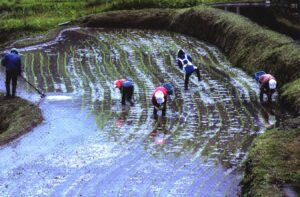
投稿タイプ:sightseeing
Kewara District
In the Kewara District in Oe-cho, Fukuchiyama City, a large number of rice paddies of various sizes spread irregularly across the steep slope of this mountainous region. These are known as terraced rice fields ("tanada"), and the gentle curves drawn by the rice paddies as they follow the slope of the hillside, and the beautiful meandering lines of the farm roads together make for quite a lovely sight to behold. Visitors can enjoy the sights of the different seasons here in Japan, with the water-filled rice paddies reflecting the blue of the sky and the white of the clouds above during planting season, and the rice stalks shining golden during harvest season. The landscape here reflects the scenery of legends and history in the Japanese countryside.
Since 1997, the Kewara District has held activities aimed at preserving the rice terraces, like the Rice Terrace Farming Tour. In July 1999, the terraces here were selected as one of the "100 Best Rice Terraces in Japan" by the Ministry of Agriculture, Forestry and Fisheries. In recent years, the locals have introduced a rice terrace ownership system, in order to make use of non-farming land. A walking path has also been installed, and a water mill has been restored, which, together with some flowers, has added some playfulness to the scenery here.
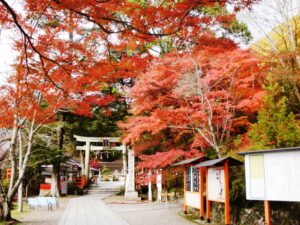
投稿タイプ:sightseeing
Izumo Dai-jingu Shrine
Izumo Dai-jingu Shrine was the most important shrine in what was once known as Tamba Province. Princess Mihotsu is the deity enshrined here, and because she was sent by the sun goddess Amaterasu to be the bride of the god Okuninushi, she has become famous as a god of matchmaking. The main shrine building is said to have been built by Ashikaga Takauji (the first shogun of the Ashikaga shogunate), and it is an Important Cultural Property. The Izumo Furyu Hana-odori dances, held annually on April 18th, are said to be Shinto rituals to bring rain, and they see an elaborate display of traditional flower hats, noble clothing from ages past, and white tabi socks on the dancers as they move to drum beats.
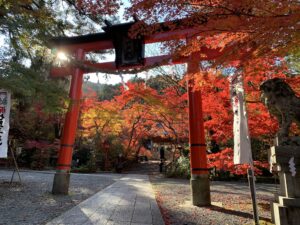
投稿タイプ:sightseeing
Kuwayama-jinja Shrine
Kuwayama Shrine in Kameoka City, located in the Woodland Kyoto area, was built in 709. The temple sits in the Kameoka basin which is said to have been a lake long ago leading to the region being perfect for farming. Kuwayama literally means "hoe mountain" and it is said that the shrine gets its name from the belief that the kami Takamitsu Omi used a hoe, or "kuwa", to carve out the valley and piled the dirt up to make the surrounding hills.
The shrine actually contains two shrines. The Kuwayama shrine, which enshrines Takamitsu Omi (Mikoto Onamuchi), and the Hachiman shrine, which enshrines Betsuson Honda (Mikoto Honda), both of which are designated by Kyoto Prefecture as registered cultural properties. There are also over 1,000 maple trees on the grounds; making it a great place to visit in the fall.
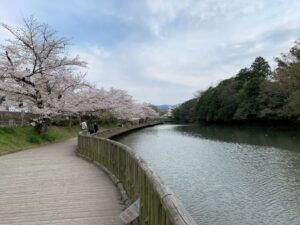
投稿タイプ:sightseeing
Nango Park
The row of cherry trees planted along the moat of the Tamba Kameyama Castle Ruins make this area ideal for taking a stroll. The weeping cherry tree in the center of the park is beautifully lit up at night, making it appear to float in the darkness.
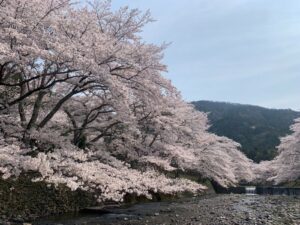
投稿タイプ:sightseeing
Nanatani-gawa River (Yawaragi Road)
Approximately 1,500 blossoming Somei-yoshino cherry trees line both banks of the Nanatani-gawa River, extending for about 1 km and making this a popular blossom-viewing location. Adjacent to the river in Sakura Park, there are approximately 280 cherry trees of 28 varieties. This is also the location of the annual Cherry Blossom Festival and associated light-up events that draw many people to see the beautiful blossom each year.
Approximately a 25 minute walk from here, you'll also find Izumo-Dai-jingu Shrine, the highest ranking Shinto shrine of the Tamba region, which has recently gained popularity as a powerful spiritual location.
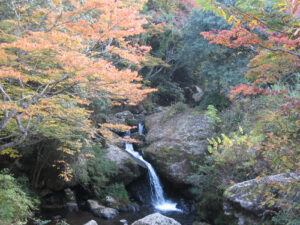
投稿タイプ:sightseeing
Rurikei Valley
Rurikei Valley, a nationally designated place of scenic and historical beauty, is a long ravine (500 meters tall and approximately 4 km long) with a spring deep in the mountains. Heading upstream towards Lake Tsuten-ko, you'll find the "12 Scenic Spots of Rurikei," including "Meibaku" (lit. "crying waterfall"), "Soryuen" (lit. "dragon pair chasm") and "Gyokusoban" (lit. "basin of running jewels")—waterfalls and cliffs with names designed to reflect their nature. So enchanting is the beautiful highland scenery to visitors as it changes throughout the seasons that Rurikei Valley has even been called "the Karuizawa of Kansai" (Karuizawa is a mountain resort in Nagano Prefecture).
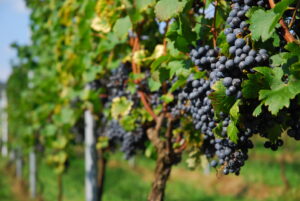
投稿タイプ:sightseeing
Kyotamba Wine
In the Kyotamba Winery, you can see the full winemaking process, from fermentation all the way to the finished product, as well as enjoy refreshments afterwards.
In the restaurant, you can enjoy cuisine made with Tamba Beef as well as various wines and cheeses. The shop also has a lot of items, such as containers for small items, that are useful for wine connoisseurs.
You can also take a tour of the vineyards to see the grapes growing on the vine.
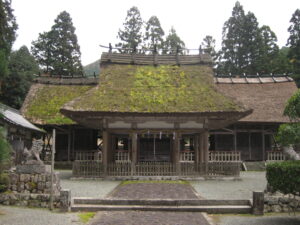
投稿タイプ:sightseeing
Make-jinja Shrine
Make-jinja Shrine was built long ago, and it is a shrine listed with the highest rank by the Japanese government. In 1079, it was visited by the Emperor Shirawa, and the shrine was honored with an imperial scroll, "Funai Dai-ichi Make-jinja." During the Edo period (1603-1868), the shrine also became a place of prayer for Koide, daimyo of the Sonobe Clan. All of the shrine buildings date to the Edo period, and both the main shrine and its auxilliary buildings have thatched roofs. The shrine grounds have a relaxed and sacred air to them.
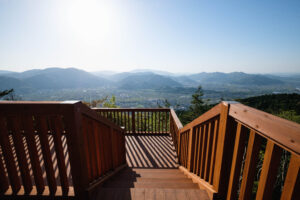
投稿タイプ:sightseeing
The Fog Terrace
The "Tamba Fog" that appears across the Kameoka Basin from autumn to spring is a unique sight for which Kameoka is known.
In the morning in particular, the scenery as viewed from the Fog terrace is wonderful, and visitors are particularly invited to enjoy it.
We recommend that you check the fog conditions online before heading out.
During fogless seasons, this is also a wonderful location from which to overlook all of Kameoka.
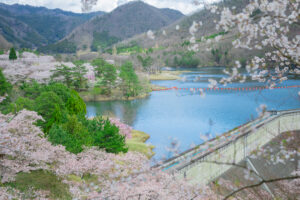
投稿タイプ:sightseeing
Ohno Dam Park
Ohno Dam Park, located in Nantan City in Woodland Kyoto, is located on the shores of Ohno Dam Lake. Surrounded by abundant nature, it is called the “Rainbow Lake” has been selected as one of the "100 Selected Dam Lakes" by the Dam Water Source Environment Improvement Center. The park is ideal for picnics and walks and includes a natural grass plaza, athletic facilities, and a walking course that goes around lake of the dam. Local residents have also planted over 1000 cherry trees and about 500 maple trees making the entire lake side awash with color; making it one of the best spots for cherry blossoms and autumn leaves in Kyoto. Every year, the "Sakura Festival" is held in April and the "Ohno Dam Momiji Festival" is held in November drawing large crowds. This means that the park is a great place to visit year round.
The Ohno Dam is a 61.4 meter high concrete dam located downstream of the Miyama River in the Yura River basin that flows from east to west near the town of Miyama and was completed in 1961. It was the first multipurpose dam in Kyoto Prefecture as it is used for both water control and power generation.
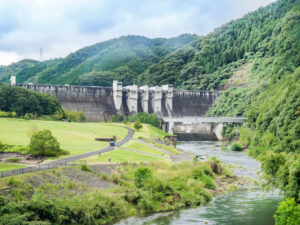
投稿タイプ:sightseeing
Hiyoshi Dam
Boasting a size that's the largest in the Kinki region, Hiyoshi Dam was the first dam opened in Japan, and its interior is open to visitors. The damn lake has an area of 2,741 square meters, a height of 67.4 meters, width of 438 meters, and a capacity of 67,000 cubic meters. Facilities open to visitors at Hiyoshi Dam include an information gallery and visitor center.
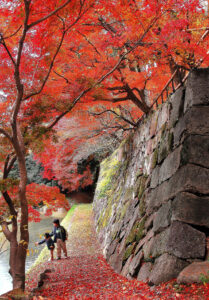
投稿タイプ:sightseeing
Omoto Headquarters (Ruins of Tamba Kameyama Castle)
In 1577, the samurai Akechi Mitsuhide, known as the assassin of warlord Oda Nobunaga, built a castle here as his base for his Tamba invasion. Hirayama Castle was built on a hill (Mt. Arazuka) overlooking the Hozu-gawa River, and it is said that Mitsuhide set forth from this castle at the time of the so-called Honno-ji Incident, during which Nobunaga was assassinated.
After the Meiji Restoration (restoration of imperial rule in 1868), the castle was destroyed in accordance with Meiji ordinances to destroy castle, but the castle's stone wall has been restored by the current owners, the religious organization Omoto. Visitors may enter via reservation, and take a look at the moss-covered stones in the middle of this tranquil forest to discover the vestiges that supported the castle for many years.
For reservations, please inquire with the Omoto Headquarters general reception.